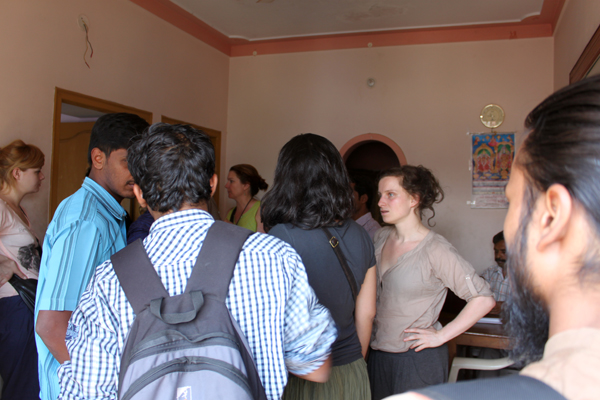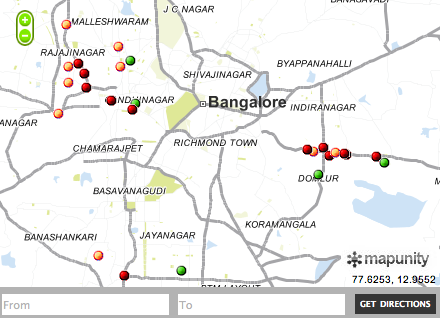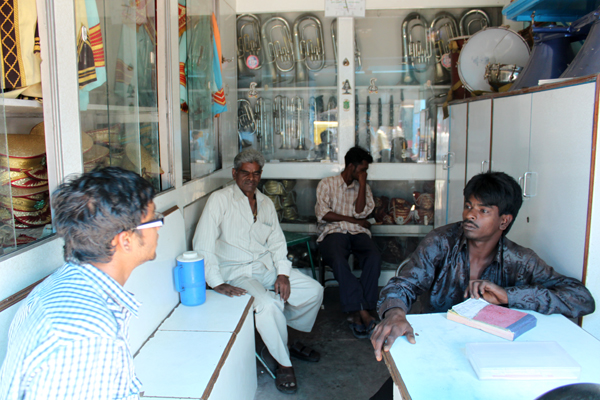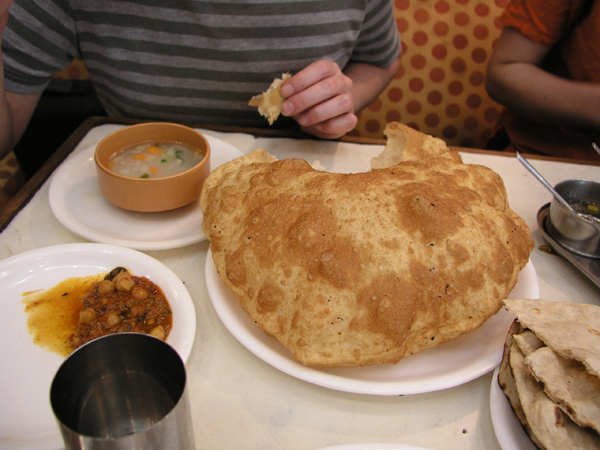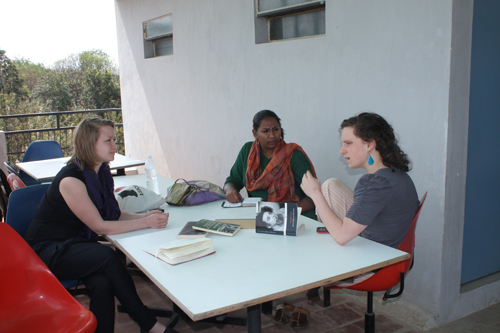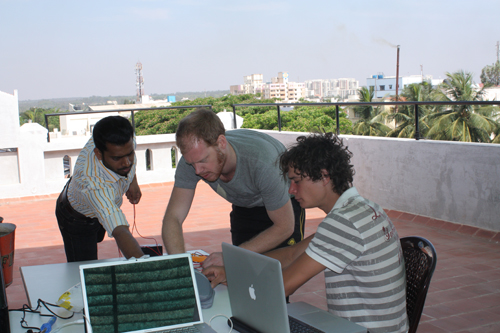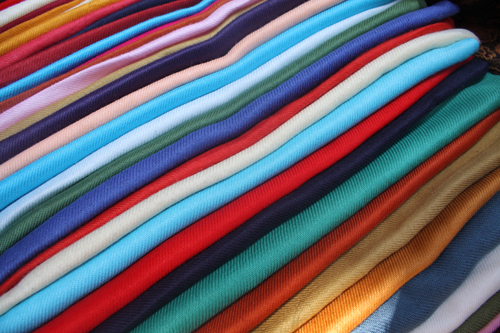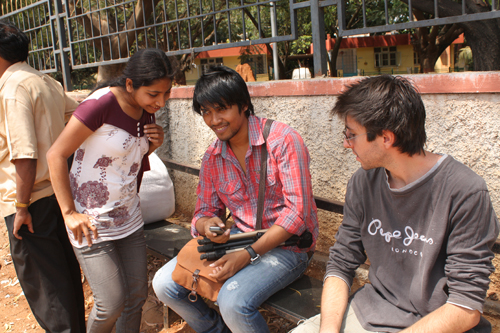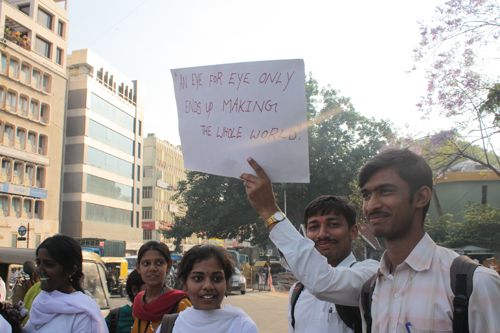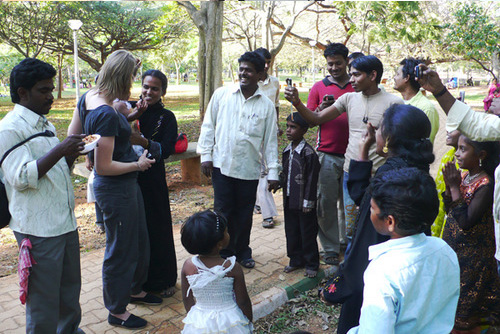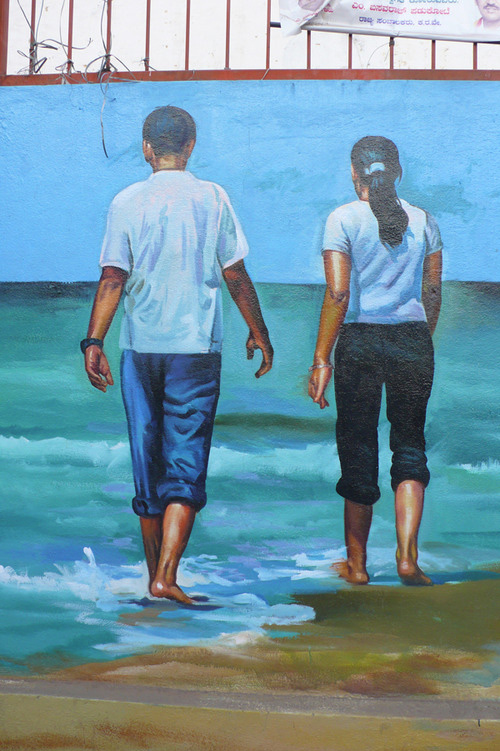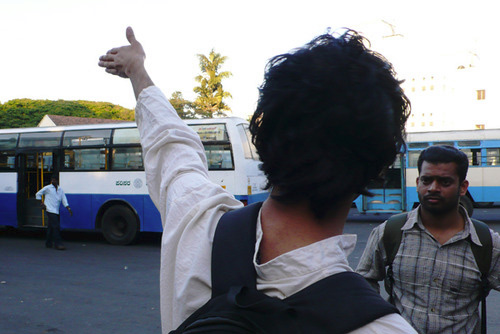Friday March 11, 2011, Bangalore, India.
Space: The final frontier
These are the voyages of the Starship, Enterprise
Its 5 year mission
To explore strange new worlds
To seek out new life and new civilizations
To boldly go where no (hu)man has gone before
First officers blog, blog entry 5.
Earth, Stardate 2011, 07:38am IST, GPS 12.963638,77.63861; Bangalore ;
A new adventure starting..
All the crew got out of their downtime on the holo deck alright. After having breakfast at the officers mesh, the crew had to report at the flight deck at 07:35am IST.
Some of the crew members had to be gathered from their quarters to report on the flight deck immediately.
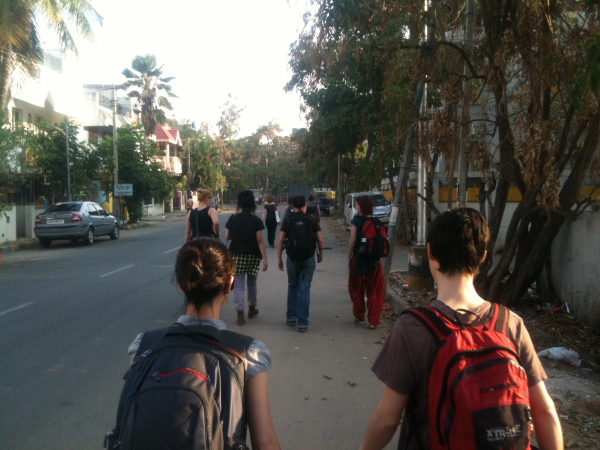
Just a few minutes to eight the brand new USS Enterprise arrives and all the crew boards. We will use the warp drive to get to our destination..
Well… we would have wished for that. It is just another bumpy ride through the already awakened but still quite fresh city of Bangalore.

The ride takes about an hour as normal. The crew is already starting to get used to this new rhythm and where able to shift their bio clock to the local time zone. We arrived at the Srishti N2 (new-new) building without any irregularities. As everywhere the people that live close by are the latest, so we are the early birds. And we all manned our position at the bridge. A pleasant surprise arrived, ‘regular’ coffee!!! (for all the caffeine junkies that are in desperate need for some while now).
Yesterday the assimilation started into different collectives. Today this will continue in between the presentations and talks that are scheduled. The Peter Brothers will share their thoughts with the engineers and technicians of the USS Enterprise.
The start of today:
• 10:00: Vasanthi’s presentation
Dr. Vasanthi Mariadass has a doctorate in Cinema Studies. Her specialization is in Film and Literary Theory (including poststructuralism, postmodernism, psychoanalysis, postcolonial studies and feminist studies). Her current research is on the works of a German documentary filmmaker Harun Farocki.
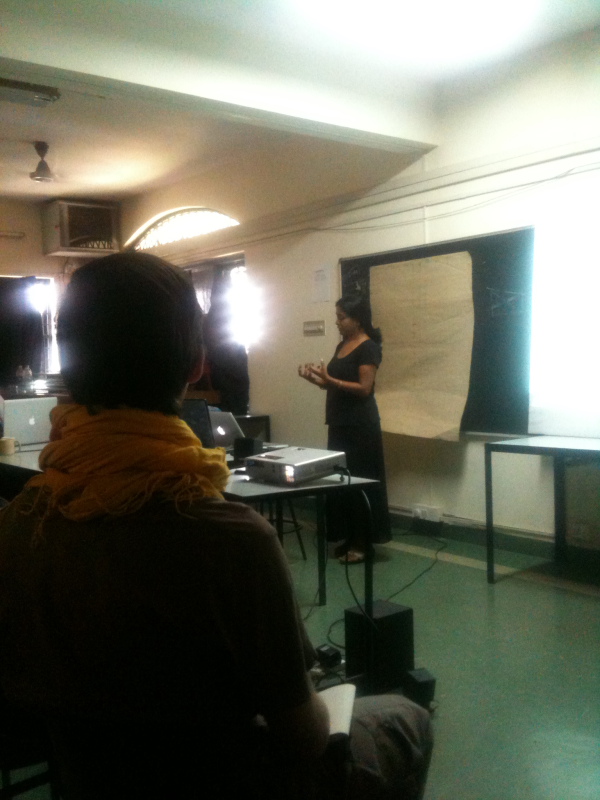
Vasanthi’s presentation addressing:
The reading of Zizeks Science of Appearance, Politics of the Real.
Vasanthi explains why her presentation is fragmented but still to be concidered integral.
For us not to worry about why it doesn’t all connect and for us to take it as discrete things and see where it flows rather than trying to engage in particular situations.
From humiliation (Copernicus, Darwin, Freud and others) to technology, where substantial reality is disturbed by for instance virtual reality.
Psychoanalysis is challenged severely by recent brain sciences.
The quasi-autonomy of appearances:
Reduction of ideology to economic base.
Freuds’ notion of fantasy (the Subjective/Objective subversion)
Drives – quasi-theological drives. De-centering of objective unconscious. Split appearances and reality.
Bhaktain: Chronotopology (chronos and topology )
Because reality is always shifting; different scales are required..
To put it in more StarTrek language:
Real entities and particals, constantly moving, constantly in a Deleuzian flux.
To engage with something that is in constant motion is almost impossible.
There are split appearences within reality. The thing is that these parallel anomolies reflect on our daily realities.
For example: as if the transporter beam malfunctioned and a person appears at 2 places at the same time.
Or as we used the replicator for an object, so that it exits in 2 places in the same time.
A space-time anomaly?
“Kirk: Come on. Spock, why didn’t you jump in?
Spock: I was trying to comprehend the meaning of the words.
McCoy: It’s a song, you green-blooded…Vulcan. You sing it. The words aren’t important. What’s important is that you have a good time singing it.
Spock: Oh, I am sorry, Doctor. Were we having a good time?
McCoy: God, I liked him better before he died.
-Star Trek V: The Final Frontier”
Demystification of concepts: 19th century: Marx, Freud
With their bodies, with their minds, with their desires
They reappear and haunt you, and you don’t know what, where and how (20th century: Zizek)
Narcissistic illnesses: exponential growth of technology.
Husserlian phenomenology: as such in their economy…the line is opened up through Bergson, Deleuze, Wittgenstein: becoming with regard to real entities.
Peter Hitchcock – ‘Chronotope of the Shoe’
About the shoe being manufactured in Indonesia, and sold for a lot of money in the States.
What is the concept of chronotope ?
Chronotopes and Architectonics
(in this article it states Michael Jordan was a Olympics runner, but I do believe he was a basketball and baseball player…)
It deals with relation: coincidental and transparent and in the end becoming and flux.
Harun Farocki => Still Life.
>Screening of 15 minutes of Farocki his film Still Life (IMDB link)
Harun Farocki – Wikipedia, the free encyclopedia
Then we discussed fetishism, starting with what fetish means, and eventually winding up with Marx’s ‘commodity fetishism’ (add link) taking into account the above. The point being how advertisement adds value to simple commodity objects (food, clothing, shoes, etc) and our desire becomes ever greater. This is always in a state flux, value placement is subjective and constantly in motion.
At around 13:17 IST we tuned out of Vasanthi’s informing and interconnecting presentation to break for lunch and discuss the concepts the 5 groups are developing.
Over lunch there will be the possibility for the groups who didn’t do it so far to talk the concepts through on technical details with the Peter Brothers.
Some people had problems with a time and space displacement:
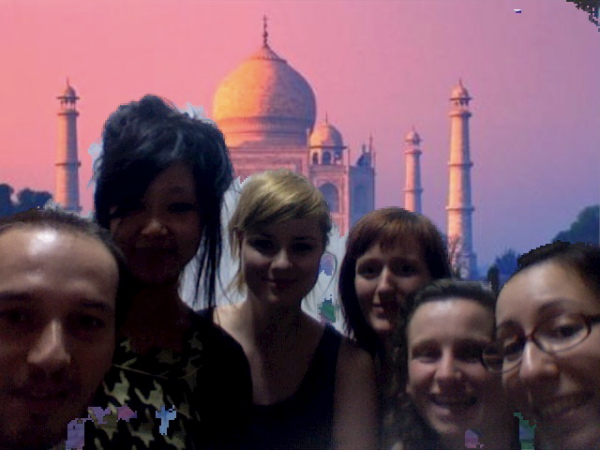
14:18 IST
Lunch break is over, all the cadets report on deck again and we will continue with the program:
• 2:00 Nishant’s presentation
Nishant Shah is the Research Director at the Centre for Internet & Society (CIS), Bangalore. Prior to CIS Nishant worked as an information architect with Yahoo, Partecs and Khoj Studios, was a Research Analyst for Comat Technologies and designed and taught several courses and workshops on the aesthetics and Politics of New Digital Media, for undergraduate and graduate level students in different universities around the world. Nishant has done his Ph.D. doctoral work from the Centre for the Study of Culture and Society, Bangalore.
Via a series of conversations Nishants wants us to shift out of our comfort zones a bit.
After clarity, enlightenment, knowledge forms, there will be no answers, but souls searching questions.
Space:
What is our response to space:
Exchange?
Medium for expansion?
What is place? What defines it?
Location based, materially available and geographical mappable (even when virtual or time or server, browser, screen…). It is always to say, this is where I am. Somebody can verify it , yes this is where you are.
There is a clear distinction between the physical present or not.
The not present being like in art , faith, Irrationality
etc.
So what is the distinction between space and place?
An entity without borders? Abstract?
How we deal with space as a value we don’t know.
Isolation, closed room?
Space is a mental concept, but in reality, time and place are physical.
Notions of space are relational and transactional.
Questions of space:
1)Questions of the body (location, ability, relations)
2)Space is not always predefined and doesn’t’ exist at same time for every one (it is not static, it is in a process, it is time based)
Space is almost fragile and is more open to protest.
3)Space is necessary in a state or rationality. Not only you define space, but also the other objects things/animals etc. (real and imaginary) define space.
It is a point of transaction and emerges over negotiation with other objects/things.
An example would be Robinsoe Crusoe.
Cyberspaces:
The term coined by Wiliam Gibson Neuromancer (1960’s)
Neuromancer - Wikipedia, the free encyclopedia
On the ‘the non-space of the mind’.
Cybernetic:ability to transfer from a to b, without loss (time, quality, etc.)
Consensual hallucinations
Hallucination: Most personal thing you can have, cannot be verified by anybody (it is in the mind..); the opposite of the real. (fe. ideologies that are in ones head and are not shared)
Consensual: How do we know that the blue as I see it is the same as how anyone else sees it? This is consensus. So cyberspace, a consensual hallucination.
Gibson: A binary that is constantly operating when you are operating in the virtual space
How to collapse this binary?
Talking about registers of different kinds of reality. VR is just one of them.
How do we understand the body and all other things/objects that surround us? This understanding is all based on consensual hallucinations. It is data that ranges in the non-space of the mind.
For example:
There is light and shadow and the area where they meet; the penumbra. The in-between of light and shadow; an interplay of light and shadow, this is the penumbra. It is here where ‘strange’ things happen.
Looking at a solar eclipse, at the perfect time, you can’t see the sun, only the shadow. But still you will see a fine line of light around the shadow…
The term penumbra explained by a text from Nishant at n.e.w.s.: http://northeastwestsouth.net/brief-treatise-despair-meaning-or-pointlessness-everything-0
A negative space, a nice example:
Rana Dasgupta – Wikipedia, the free encyclopedia :
(novel ‘Solo’) writes in style and overproduction of non-meaning (non-space of meaning).
review:http://www.guardian.co.uk/books/2010/mar/28/solo-rana-dasgupta-book-review
Space is defined as an emptiness of a kind, image a world there is no vacuum, no emptiness.
Space will constantly need other objects to define it self, otherwise there would not be anything to define space by.
Question: How do you build a net?
Answer: You take a lot of holes and put them to gather.
“Dr. Crusher: Computer, what is the nature of the universe?
Computer: The universe is a spheroid region, 705 meters in diameter.
Quantum:
The ability to think that or believe there exists a universe that every single thing that can happen that will happen.
The quantum takes away the space from the equation, from the ‘universe’.
If everything can happen, also nothing can happen. So there won’t be space.
For instance a writer from Singapore: Chua Beng Huat http://en.wikipedia.org/wiki/Chua_Beng_Huat
In Singapore there is no space for citizenship, only the state. You want to buy chewing gum, but no you cannot chew.
You have to negotiate with yourself, while it is a police state and nobody else will argue with you.
An interesting question: “What happens to the table when I am not looking at it??” (novel by Virginia Wolff)
On relation of time to space.
Andy Clarke http://en.wikipedia.org/wiki/Andy_Clark : ‘the natural born cyborgs’ (time is a human born construction). We are creatures of the present and have constructs over history which pushes us into the future.
Why are we looking forward into the unknown, instead of looking into what we know (in the past)
(‘the Troll’ by Andy Clark).
The Troll: http://openpolitics.ca/Troll+Age
In cyberspace the decay of time is different than in the real. The non-space encompasses non-time.
Also in this context it might be good to check the Frankfurt School:
Frankfurt School – Wikipedia, the free encyclopedia
A member of the Frankfurt School; Siegfried Kracauer wrote interesting pieces about the non-space.
Siegfried Kracauer – Wikipedia, the free encyclopedia
Siegfried Kracauer: An Introduction. – Princeton University Press
Physical non-space; something that belongs to 2 nation states. It is the in between between different places.
Examples; airports, or hotel lobbies (before you checked in).
The feature film the Terminal shows a funny/interesting example of this.
The Terminal - Wikipedia, the free encyclopedia
Just a remark in between; digital technology is not only about tools; so don’t just take it for granted. They are also conceptual tools.
3 models of defining space: (or rather non-space)
1) The location based model
Space is understood of a location from which stories can be told. An anchor for relationships between pause and effect (narration, or narrative space) in a construct of time.
In the early 90’s; a group of people created a MUD, Multiple User Dungeon (text based adventures, one of the first) ’Lamba Moo’ (greek letters). In this game of Lambda Moo, in room 17 something strange happened. There was the action of the first cyber rape in history.
Julian Dibbell » A Rape in Cyberspace
http://www.media-ecology.org/publications/MEA_proceedings/v1/virtual_misbehavior.html
2) For archeologists’, space would be based on what one would find in that space. If nothing is found in that space it wouldn’t be a space, but that is just too easy. The second model would be geological model of space. Every piece of earth is valid. Geologists place themselves in that construct of space (everyday practices).
Question: Why don’t we make archives of unimportant things? We only make archives of ‘important things’
3) And the last being the model of affect space. Affect cannot be quantified (like love for instance), things/objects that cannot be materialistically represented. So relationships will fit this.
For technology, we relate to this in access (the economical access), these people are ‘outside’ the online space. (12.5% of 1.2 billion in India).
We, people, are starting to develop affectuous relations with technology;
Example of a city in India that was moved to ‘make’ internet available. Nishant will make his text available (will be linked here).
An other example would be Michael Goldman on Bangalore:http://bangalore.citizenmatters.in/articles/view/304-world-city-talk .
15:57 IST;
Now we just went through some warp holes and could barely manoeuver our way out of a black hole, in the end all our brains are starting to be mixed up.
So a 10 minutes break… before we continue with Hans, but first….
a space anomaly encountered in Bangalore..
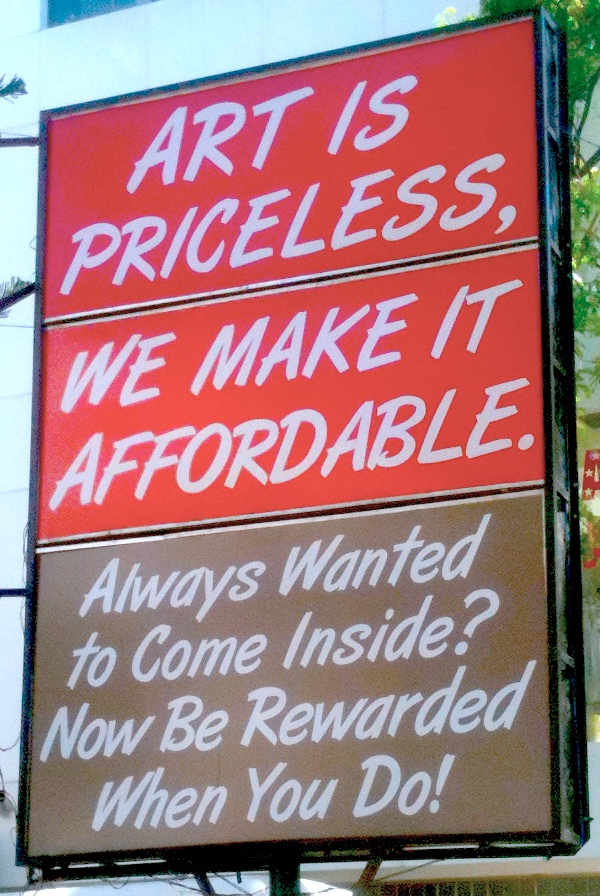
And even during the break the discussion with Nishant continued:
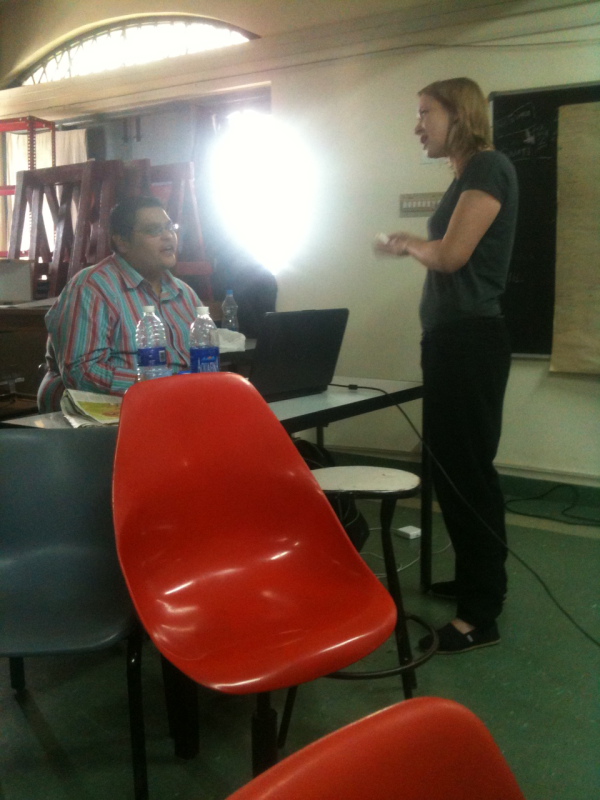
• 16:12 Hans’ presentation
Hans Varghese Mathews read philosophy as an undergraduate, at the University of Southern California, studying logic and aesthetics; and went on to obtain a doctorate in mathematics, from the University of Wisconsin, studying algebraic topology primarily, with mathematical logic and philosophy as subsidiary subjects. He has an abiding interest in the formal understanding of painting and poetry; and a more recent and dominating interest in the mathematisation of the social sciences.
In regard to the metaproject of ‘Space the Final Frontier’ whereby we are indexing the ‘shadow worlds of Bangalore’, Hans was asked to help us think through how we can build a database of our projects, in relation to already existing examples along with how we would define those parameters:
Starting with the use of FLICKR, a query on non-space
http://www.flickr.com/search/?w=all&q=you%27ll+meet+a+dark+stranger&m=text
You have to enter text when you upload pictures to Flickr (there are a lots of words other people already entered).
Information has to be added for other people to be able to search the database.
A search will be done on the base of similarities. In the query you’ll enter words, the search will be looking at similarities in the database and the query. The more similarities, the better the match;
A measure of similarities would be the cosine similarity or cosine measure: http://en.wikipedia.org/wiki/Cosine_similarity )
‘Latent semantic indexing’ (Latent semantic indexing - Wikipedia, the free encyclopedia )
Singular value decomposition (SVD) http://en.wikipedia.org/wiki/Singular_value_decomposition
Structures and/or dimensions of preferences (by describing a space to a reference point), the space of preferences.
(If people like to go into the subject deeper http://en.wikipedia.org/wiki/Eigenvalue )
M=U{SUM}V*
http://en.wikipedia.org/wiki/Rank_of_a_matrix
“We are all getting more and more confused and away from home in this world of mathematics which Hans is trying to broadcast to all of the crew members of the Enterprise…”
So for just getting our feet back to the ground; the concept of the matrix would be a basic ‘xls-sheet’.
The matrices don’t have to be static in time and the question for the SVD would be how many times the matrix would be updated.
Hans is getting everyone confused:
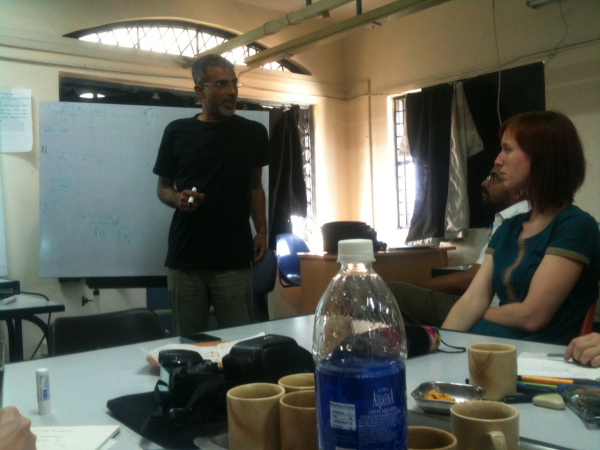
Hans adds extraneously: An interesting read could be: http://en.wikipedia.org/wiki/Arthur_Danto
on the Animals as Art Historicans .
Back to matrices and searching.
For computers it is quite easy to process words, but it is much harder to compare if pictures are alike.
After a query on words and adding the feedback of the most searched object clicked on by users the list is rearranged accordingly to popular clicks.
And this brings us to ‘page ranking’
PageRank – Wikipedia, the free encyclopedia
A notion of relevance:
The meaning of algorithm traversal might get clearer by looking at ‘tree traversal’ at wikipedia
http://en.wikipedia.org/wiki/Tree_traversal
To talk about indexing; KISS, keep it simple stupid..
Some theory in practice:
Photosynth website:http://photosynth.net/
Photosynth launch presentation:
http://www.ted.com/talks/blaise_aguera_y_arcas_demos_photosynth.html
And of course in the end Hans leaves us in complete confusion about matrices and cross searches and algorithms at exactly 17:00 IST.
The really friendly Peter Brothers say goodbye and thank all the participants for being so an perceptive audience. They have been a great help for most of our projects. Many thanks for that from all of us!!
The crew spreads out and the Enterprise crew members find out that the Enterprise already has taken off. They had to find an alternate way to get home. Captain Kirk escaped in a small in a small shuttle on a separate mission.
“It was…fun…
-James Kirk, on life, Star Trek: Generations”
Eelco,
out.
